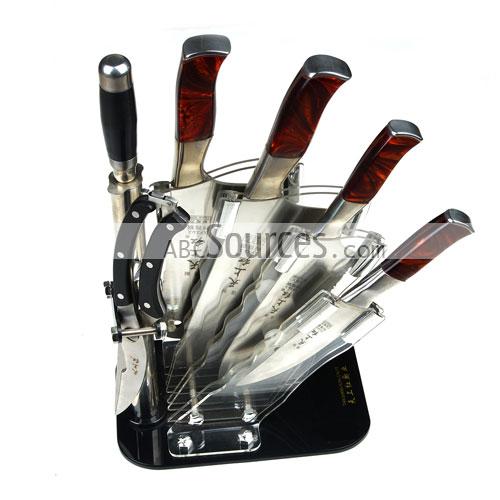Buying Guide-How to Choose a Kitchen Knife Set
-
Not all kitchen knives are equal – often a fashionable brand can be found selling poor quality knives at a high price, while it is possible to find a better quality set for cheaper with a lesser known brand.
\r\nSince kitchen knives will be an investment that is used daily for all your cooking days, selecting good quality ones that have durability, strength, good handling, and endurance is a must.A complete kitchen knife set can provide nearly every tool an amateur chef will need. A good knife set is not cheap, but with proper care it can turn into a family heirloom handed down through the generations. In this article, you'll learn what to look for when you go shopping for quality kitchen knives.
\r\n
\r\n\r\n
\r\nInstructions:
\r\n1.Plan on building a knife set over time. Unless cost is no object, a high-quality knife set can be accumulated piece by piece. While it might be satisfying to see a full set of knives proudly displayed in a case atop the kitchen counter, most of us cannot afford the financial outlay a complete set of quality cutlery demands. Buying knives over time allows you to decide what cutlery your cooking style needs, as well as which brands you prefer, writes Beard in his classic text "Theory and Practice of Good Cooking." A savvy shopper, however, can find quality knife sets online. Smaller "starter" sets can be expanded as your needs change. You are more likely to get a good deal from a kitchen equipment supply house than by buying directly from the manufacturer. This doesn't mean the knives are "factory seconds" or lower-quality products, just that supply houses benefit from buying in bulk.
\r\n
\r\n2.Learn the lingo. Just like buying diamonds involves learning the language of jewelers, the cutlery industry has a vocabulary all its own that you'll want to master. Kitchen knives generally have three parts, each of which is equally important. The first part is the blade, which is divided into the cutting edge, the spine and the point. At the back end of the blade is the tang, which is attached to the handle, and is either "full" or "stick." A full tang runs the length of the handle and is usually stronger; a stick tang is shorter and allows for more ergonomic handle designs. Between the blade and tang is the bolster, which gives more weight to the knife and balances it.
\r\n
\r\n3.Look for quality manufacturing. The best knives are forged from high-carbon stainless steel. They hold their sharpness longer and are more durable. Less expensive knives are stamped from steel and ground to sharpness. These knives do not stay sharp and over time sharpening reduces the knife's effectiveness. The handle of the knife is less crucial but still should be considered. There is nothing wrong with a knife whose handle is attached with rivets, provided the rest of the knife evinces quality manufacturing. Expect to pay more than $100 for a quality 8-inch chef's knife from a top-of-the-line manufacturer. Other essential knives are slightly less expensive. Prices for sets range widely. A 23-piece knife set from one of the top manufacturers is priced online at more than $1,900. Fortunately, a good eight-piece starter set ranges from about $200 to $400, depending on the maker and manufacturing process.
\r\n
\r\n4.Select the appropriate knife for the work you want it to do. Start by buying an 8- or 10-inch chef's knife. The chef's knife should feel heavy near the handle and should fit comfortably in your hand. Other essential starter knives are the paring knife, which resembles a small chef's knife, and the slicing knife, which has a rounded tip and is used to cut meat. From there, consider additions like a serrated bread knife, a boning knife and a cleaver. Don't feel married to a particular brand. Uniformity of manufacturer looks nice in the knife rack, but how the knife performs is paramount.
\r\n
\r\nTips
\r\n
\r\n
\r\n- \r\n
- Most of the cheap blades, especially your imported blades, are made of low quality stainless steel. There are many grades of stainless steel, and each has its own application. Surgical stainless steel will make a great scalpel, but it will never make a decent kitchen knife. They often tend to go blunt quickly and take a very long time to sharpen again. The more you sharpen them, the harder they are to keep sharp. They tend to push up burrs along the blade which clog a whet-stone. Many of these tiny micro-shards of metal can become fatigued and work off into your food. Many claim to be 440 stainless, but they are usually much softer. \r\n
- If buying knives with your partner or family it can be harder to pick a good set. In a perfect world each should have their own set but as that's not always cost effective, so choose knives that meet a middle ground for a good compromise. \r\n
- While in modern times, much of our food already comes to us pre-cut, the need for a wide variety of knives is actually less nowadays than it used to be. But at the same time there is a big increase with people interested in developing more advanced cooking skills so it is recommended to buy quality as the task becomes much easier. \r\n
- There's no such thing as a "Never Needs Sharpening" knife. They just don't hold up. They are not "Never Needs Sharpening", they are can't be sharpened. How many people do you know who own a 20 year old Ginzu steak knife? \r\n
\r\n
\r\n
Related Articles

